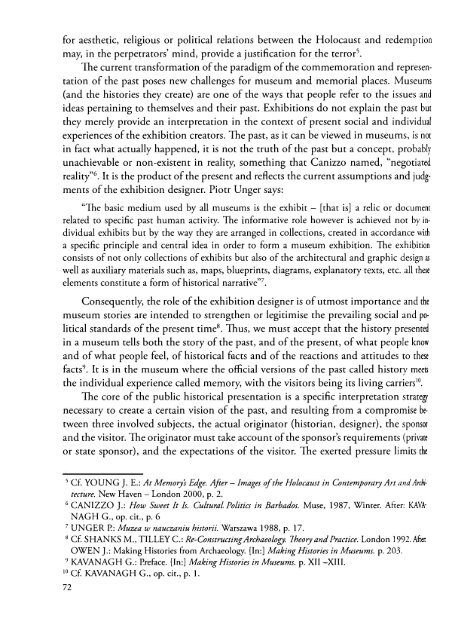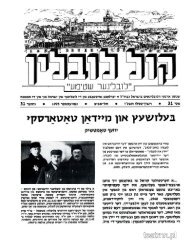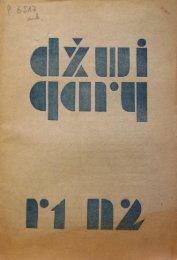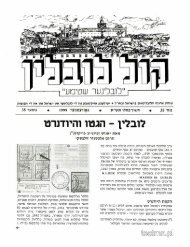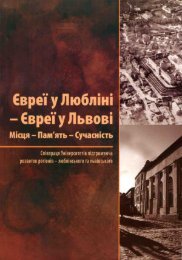The Jews in Lublin - Biblioteka Multimedialna Teatrnn.pl - Brama ...
The Jews in Lublin - Biblioteka Multimedialna Teatrnn.pl - Brama ...
The Jews in Lublin - Biblioteka Multimedialna Teatrnn.pl - Brama ...
Create successful ePaper yourself
Turn your PDF publications into a flip-book with our unique Google optimized e-Paper software.
for aesthetic, religious or political relations between the Holocaust and redemption<br />
may, <strong>in</strong> the perpetrators' m<strong>in</strong>d, provide a justification for the terror 5 .<br />
<strong>The</strong> current transformation of the paradigm of the commemoration and representation<br />
of the past poses new challenges for museum and memorial <strong>pl</strong>aces. Museums<br />
(and the histories they create) are one of the ways that peo<strong>pl</strong>e refer to the issues and<br />
ideas perta<strong>in</strong><strong>in</strong>g to themselves and their past. Exhibitions do not ex<strong>pl</strong>a<strong>in</strong> the past but<br />
they merely provide an <strong>in</strong>terpretation <strong>in</strong> the context of present social and <strong>in</strong>dividual<br />
experiences of the exhibition creators. <strong>The</strong> past, as it can be viewed <strong>in</strong> museums, is not<br />
<strong>in</strong> fact what actually happened, it is not the truth of the past but a concept, probably<br />
unachievable or non-existent <strong>in</strong> reality, someth<strong>in</strong>g that Canizzo named, "negotiated<br />
reality" 6 . It is the product of the present and reflects the current assumptions and judgments<br />
of the exhibition designer. Piotr Unger says:<br />
"<strong>The</strong> basic medium used by all museums is the exhibit — [that is] a relic or document<br />
related to specific past human activity. <strong>The</strong> <strong>in</strong>formative role however is achieved not by <strong>in</strong>dividual<br />
exhibits but by the way they are arranged <strong>in</strong> collections, created <strong>in</strong> accordance with<br />
a specific pr<strong>in</strong>ci<strong>pl</strong>e and central idea <strong>in</strong> order to form a museum exhibition. <strong>The</strong> exhibition<br />
consists of not only collections of exhibits but also of the architectural and graphic design as<br />
well as auxiliary materials such as, maps, bluepr<strong>in</strong>ts, diagrams, ex<strong>pl</strong>anatory texts, etc. all these<br />
elements constitute a form of historical narrative" 7 .<br />
Consequently, the role of the exhibition designer is of utmost importance and the<br />
museum stories are <strong>in</strong>tended to strengthen or legitimise the prevail<strong>in</strong>g social and political<br />
standards of the present time 8 . Thus, we must accept that the history presented<br />
<strong>in</strong> a museum tells both the story of the past, and of the present, of what peo<strong>pl</strong>e know<br />
and of what peo<strong>pl</strong>e feel, of historical facts and of the reactions and attitudes to these<br />
facts 9 . It is <strong>in</strong> the museum where the official versions of the past called history meets<br />
the <strong>in</strong>dividual experience called memory, with the visitors be<strong>in</strong>g its liv<strong>in</strong>g carriers 10 .<br />
<strong>The</strong> core of the public historical presentation is a specific <strong>in</strong>terpretation strategy<br />
necessary to create a certa<strong>in</strong> vision of the past, and result<strong>in</strong>g from a compromise between<br />
three <strong>in</strong>volved subjects, the actual orig<strong>in</strong>ator (historian, designer), the sponsor<br />
and the visitor. <strong>The</strong> orig<strong>in</strong>ator must take account of the sponsor's requirements (private<br />
or state sponsor), and the expectations of the visitor. <strong>The</strong> exerted pressure limits the<br />
5<br />
Cf. YOUNG J. E.: At Memory's Edge. After — Images of the Hobcaust <strong>in</strong> Contemporary Art and Architecture.<br />
New Haven — London 2000, p. 2.<br />
6<br />
CANIZZO J.: How Sweet It Is. Cultural Politics <strong>in</strong> Barbados. Muse, 1987, W<strong>in</strong>ter. After: KAVA-<br />
NAGH G., op. cit., p. 6<br />
7<br />
UNGER P.: Muzea w nauczaniu historii. Warszawa 1988, p. 17.<br />
8<br />
Cf. SHANKS M.,TILLEYC.: Re-Construct<strong>in</strong>g Archaeology. <strong>The</strong>ory and Practice. London 1992. After<br />
OWEN J.: Mak<strong>in</strong>g Histories from Archaeology. [In:] Mak<strong>in</strong>g Histories <strong>in</strong> Museums, p. 203.<br />
9<br />
KAVANAGH G.: Preface. [In:] Mak<strong>in</strong>g Histories <strong>in</strong> Museums, p. XII -XIII.<br />
10 Cf. KAVANAGH G., op. cit., p. 1.<br />
72


